[:en]
In December 2015, I changed for the ‘enteenth time my task management tool, as always incorporating new ideas harvested from the failures of my past systems and, for the first time in 7 or 8 years, I created one that really works.
I’ve used the same system for a year now and not only can I say that it consistently prove itself valuable as a way to manage tasks but it also affords me an opportunity I never had before : to revisit (in staggering detail) my year from the point of view of my realizations.
So this year, I accomplished on 358 tasks this year
and in that I found 24 milestones.
I can say with confidence that 2016 was a good year for me
and I am proud of that.
This article intends on providing a brief description of the tool used and providing my year in review as the case study for it’s success. I’m sharing this in hopes of helping my peers feel more accomplished while actually accomplishing stuff.
Case Study : my 2016 in review
This morning, December 31st 2016, I counted 358 entries in my archive since the creation of this tool (which will be 359 once I publish this article).
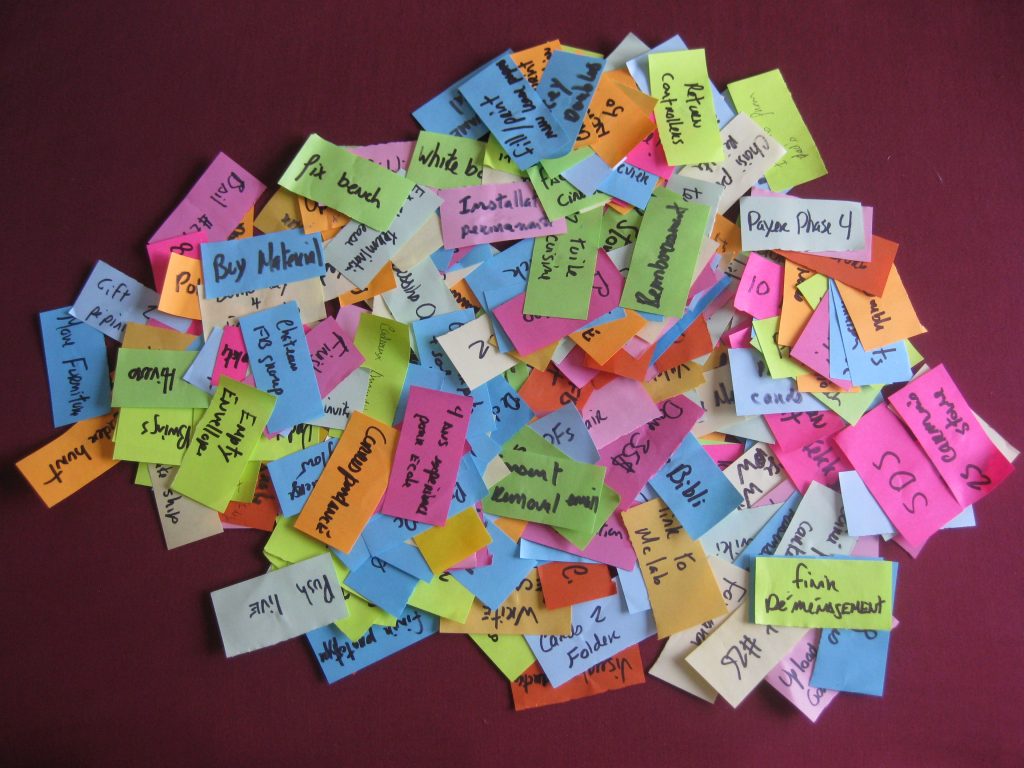
That’s a very encouraging number.
That being said, the scope of these tasks vary quite a bit.
Some are of the utmost insignificance in hindsight :

Most were mundane unremarkable little steps
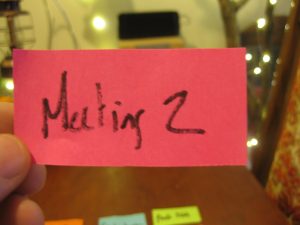
Others help remember problems long since fixed and forgotten :

and yet others refresh the memory of a faded pleasant experience :

While others confirm once again that taking care of friends always merits my attention and focus :

All these help tell a story of my year, and reviewing them helped strenghthen the idea that this year, I indeed did great things.

But most of all, I am floored at the scope of my milestones :
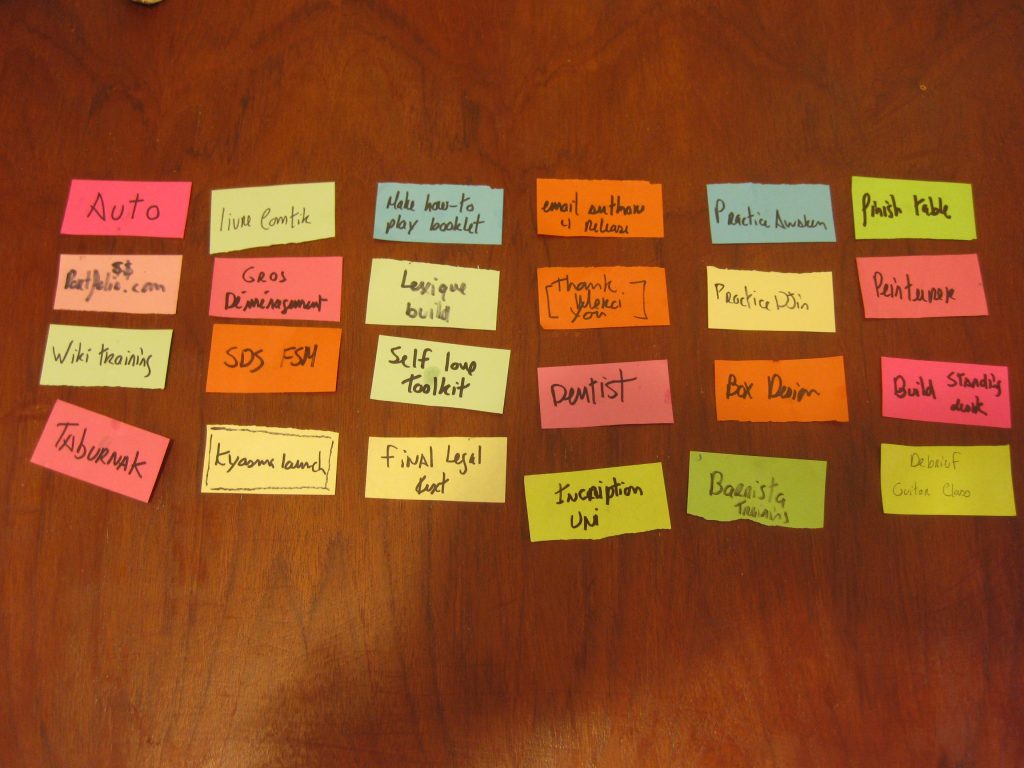
These highlights run the gamut from significant to outstanding to downright miraculous. I expected 10 when I started unpacking my archive, I ended with 24!
So, thanks to this tool, I can now remember that
This year, I
- Released 3 books
- published a collaboratively produced card game
- opened this website
- started DJing
- performed a cappella at a strange participatory concert of my creation
- learned photoshop,
- learned about how to manage a Wiki (stay tuned for that one 😉 )
- Moved (twice)
- bought a car
- build myself a standing desk from old church wood (and built moe things than I ever built before)
- started taking care of Silent Disco Squad in Montreal
- Started giving guitar classes
- learned how to make awesome coffees from a master Barrista
- Started teaching people about Tarot
- learned about lots of legal stuff regarding contracts and rights of publication
- went through the entire process of inscribing in a university program only to choose to continue working like this
- AND took care of my mental health like never before
This is an astounding reflection; and since it is now time to sculpt the portrait of 2017’th dreams and objectifs, could this have come at a better time?
The Tool
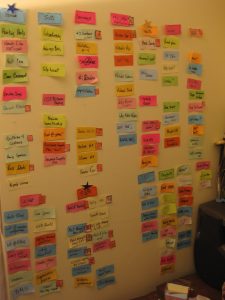
The system itself is stupid simple.
It all starts with non-sticky post-it notes cut in halves. On these halves are written single tasks. Along side the sticky notes I have 2 other devices :
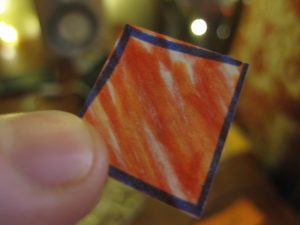
Little red squares to highlight which tasks are upcoming

and blue stars to bring attention to certain projects & priorities
The whole thing sticks to the wall using Blu-tack and is placed next to your workstation.
It works like this :
Families of tasks (different projects / subjects / categories) are headed by a framed post it note :

Subsequent tasks within this category simply have no frame :
Task families of current focus get a star (i.e. “Project A”, “Home Renovations” and Writing a Book”). Try to limit yourself to 3 focuses at once max – and stick with them for long periods of time (i.e. months).
Tasks of upcoming importance / urgency get one of many red squares (I have 15 total right now. I also made little squares with 1, 2 and 3 on them to highlight my primary secondary and tertiary priorities.
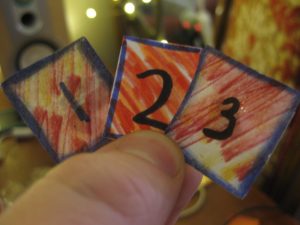
Once tasks are completed, they go into an archive for future review. Tasks that are abandoned are discarded (not archived).
I tend to do daily debriefs to archive completed tasks and to add new tasks as they appear. Weekly or bi-monthly, I re-evaluation the whole system to redistribute priority squares to make sure everything is balanced and taken care of.
And there it is, that’s the whole system.
Those in the know may recognize all this as a form of scrum altered by Eisenhower’s Urgent/Important Principle, and they’d be right.
A great many thanks to all my friends, allies and supporters for a wonderfully successful year.
may your 2016 and the years ahead be fertile and bountiful.
Much love
Matthieu R[:fr]
En Décembre 2015 j’ai changé pour le enième fois mon système de gestion de tâches, comme toujours grâce aux échecs des dernières incarnations qui me servaient de généreuses sources d’inspiration pour son amélioration et, pour la première fois en 7 ou 8 ans, je semble avoir créé un outil qui fonctionne très bien.
J’utilise maintenant ce système depuis 1 an. Non seulement sait t’il me surprendre continuellement due à sa grade agilité à supporter mes réalisations mais il m’offre une opportunité jusqu’à maintenant absente : la possibilité de passer mon année en revue détaillée de la perspective de mes réalisations.
Cette année, j’ai accomplie 258 tâches
et de celles-ci, 24 sont des réalisations majeures.
Je peux aujourd’hui dire que 2016 fut une bonne année pour moi
et ceci me procure beaucoup de fierté.
Cet article cherche à vous offrir une descritpion briève du système tout en s’appuyant sur mon année en revue comme example démonstratif de son succès. Je partage ceci dans l’espoir de vous aider tous à vous sentir plus accomplis en ces fins d’années tout en contribuant à votre capacité de réellement accomplir sur vos objectifs.
Cas d’étude : Mon année en revue
Ce matin, le 31 décembre 2016, j’ai conté 358 entrés dans mon archive ( qui montera à 359 à la publication de cet article :P).

Ce chiffre m’est très encourageant.
Il va de soit que la complexité des tâches en question varie grandement de l’une à l’autre.
Certaines entrés semblent complètement insignifiantes en perspective :

et la plupart ne sont que de petites réalisations sans gloire qui s’inscrivent sous une plus grande réussite. (voir “Meeting 2” ci-haut 😛 )
D’autres aident à revisiter des problèmes résolus et ainsi oubliés:

tandis que d’autres encore aident au souvenir de très beaux moments :

et certains m’aident à comprendre que le soin de ses proches mérite sans doute mon attention et ma dévotion :

Cette récolte compte une histoire qui me plait concernant mon année et m’aident à enforcir l’impression que cette année, j’ai réalisé beaucoup de belles choses.

Surtout, c’est le portait de mes plus grandes réalisations qui me garde étonné et encouragé face à l’année à venir :

Quand je me suis assis pour revisiter mon archive, je m’attendais à y trouver une dizaines de réalisations significatives donc vous comprendrai ma surprise quand ce nombre s’éleva à plutôt à 24!
Ainsi, grâce à cet outil de révision, je comprends que,
Cette année j’ai
- Réalisé la production de 3 livres
- publié un jeu de carte
- ouvert ce site web
- commencé à produire des mix entant que DJ
- performé a cappella pendant un concert participatif de ma création
- appris comment utiliser photoshop,
- appris à entretenir un Wiki (plus d’info sur ceci en 2017 😉 )
- déménagé (deux fois)
- acheté une auto
- construit un bureau de travail avec du vieu bois d’église
- construit tout plein d’autres petites choses pour la maison, plus de travail manuel que j’ai fait de toute ma vie
- prit en charge Silent Disco Squad Montreal
- Commencé à donner des cours de guitar
- Appris à vous faire de superbes cafés grâce à une maitre Barrista
- Commancé à pffrir des cours de Tarot
- Appris beaucoup à propos des lois sur les droits de publications
- Complété un processus d’inscription à l’université ET choisi de retirer mon application
- et j’ai prit soin de ma santé mentale comme jamais auparavant.
Ceci est un reflet incroyable de mon année; et quel merveilleux moment de recevoir ce renforcement positif qu’à la veille de la nouvelle année, temps parfait pour mettre en place les rêves et les objectifs pour 2017?
L’outil

Ce système est d’une simplicité élémentaire.
Tout s’appuie sur des post-its sans adhésif coupés en deux moitiés. Sur ces moitiés on y inscrit des tâches singulières. Pour accompagner ces moitiés, j’utilise aussi deux autres indicateurs :

De petits carrés rouges cartonnées pour indiquer quelles tâches sont les prochaines à réaliser

et des étoiles blues pour attirer l’attention sur certains projets prioritaires.
Le tout colle au mur grace à de la gommette blue (Blu-tack) et est placé prêt de votre espace de travail.
Comment l’utiliser?
Pour les grandes familles de tâches (different projets / sujets / catégories), vous leur donnez un nom ainsi qu’un cadre :

Les tâches sous ces familles n’ont simplement pas de cadre :

Les familles de tâches d’importance actuelle sont étoilées (tels “Projet A”, “Rénovations” et “Écrire mon livre”). Limitez vous à 3 étoiles à la fois et tentez de leur rester fidèles pour un certain temps (disons un ou quelques mois).
Les tâches d’importance éminentes reçoivent un carré rouge; notez qu’en tout temps je peux avoir prêt de 15 carrées en circulation à la fois. J’ai aussi construit de petits carrées numérotés pour indiquer mes priorités primaires, secondaires et tertiaire.

Une tâche compléter se fait archiver (dans une enveloppe hors de vue) tandis que les tâches abandonnées se font détruire.
J’ai l’habitude de faire un debrief journalier pour archiver les tâches complétées et pour ajouter de nouvelles tâches au besoin et je me réserve un moment à chaque semaine ou au deux semaines pour redistribuer les carrés de priorité pour assurer que tous les aspects de ma vie ont l’attention dont ils ont de besoin.
Et, c’est tout!
Pour ceux qui le remarquerais, tout ceci est en effet une forme de scrum altéré par le Principe Urgent/Important de Eisenhower.
Je tiens à remercier mes amiEs, alliéEs et partenaires pour cette année pleine de réussites.
Je vous souhaite un 2017 fertile et riche en récolte.
Amour
Matthieu R[:]
